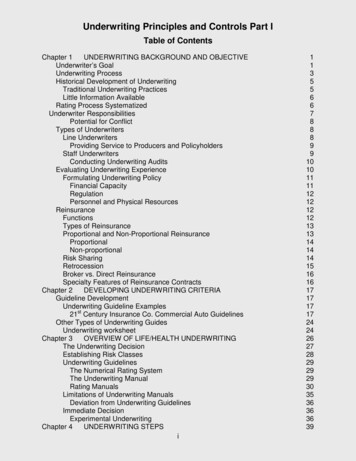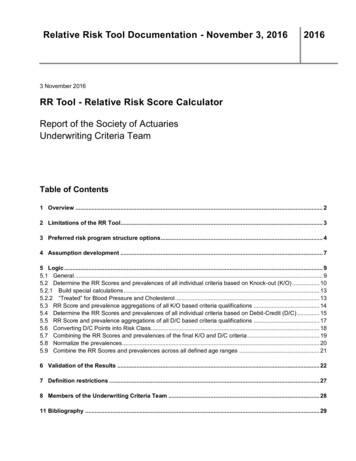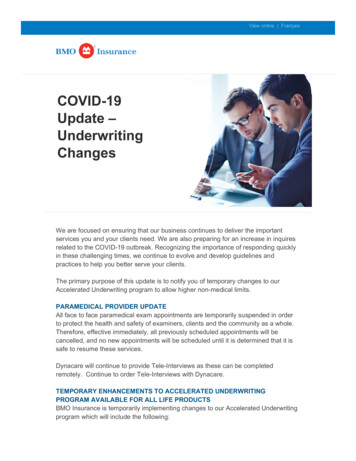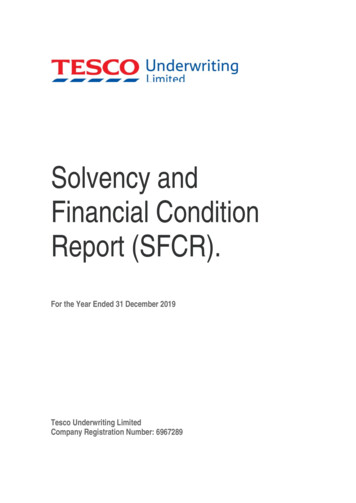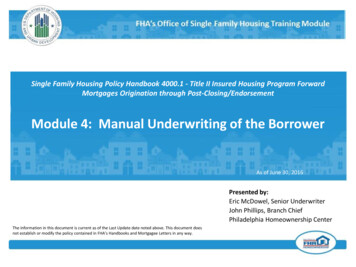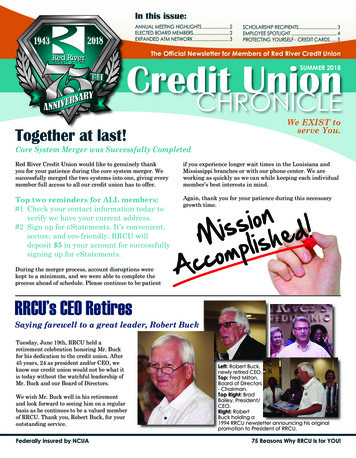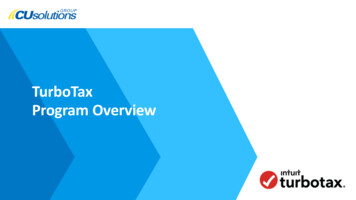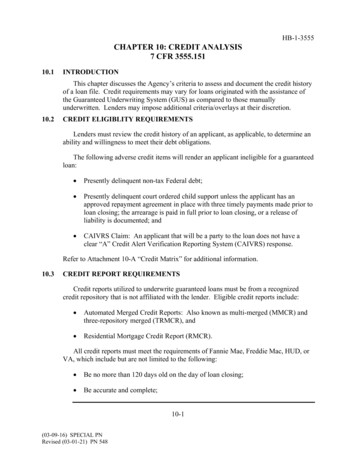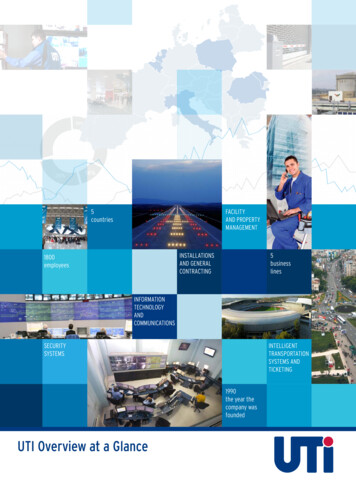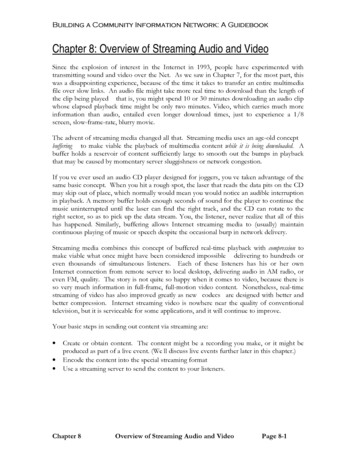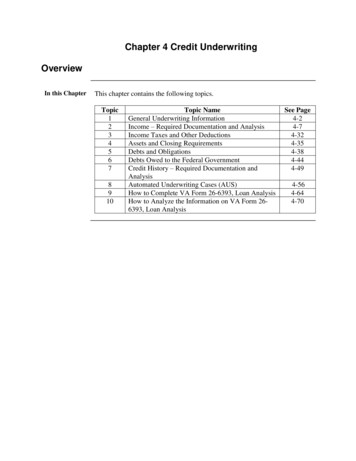
Transcription
Chapter 4 Credit UnderwritingOverviewIn this ChapterThis chapter contains the following topics.Topic12345678910Topic NameGeneral Underwriting InformationIncome – Required Documentation and AnalysisIncome Taxes and Other DeductionsAssets and Closing RequirementsDebts and ObligationsDebts Owed to the Federal GovernmentCredit History – Required Documentation andAnalysisAutomated Underwriting Cases (AUS)How to Complete VA Form 26-6393, Loan AnalysisHow to Analyze the Information on VA Form 266393, Loan AnalysisSee Page4-24-74-324-354-384-444-494-564-644-70
VA Pamphlet 26-7, RevisedChapter 4: Credit Underwriting1. General Underwriting InformationChange DateFebruary 22, 2019 This chapter has been revised in its entirety.a.UnderwritingInformationVA Underwriting Standards require lenders to always utilize the followingguidance when underwriting VA-guaranteed loans:Lenders are encouraged to make VA loans to all qualified Veterans who apply.VA’s underwriting standards are intended to provide guidelines forunderwriters. Decisions must be based on sound application of the standards,and underwriters are expected to use good judgment and flexibility in applyingunderwriting guidelines. Not all possible circumstances are addressedtherefore, underwriters must apply reasonable judgment and flexibility inadministering this important Veterans’ benefit.b. BasicRequirementsBy law, VA may only guarantee a loan when it is possible to determine thatthe Veteran is a satisfactory credit risk, and has present or verified anticipatedincome that bears a proper relation to the anticipated terms of repayment.VA’s underwriting standards are incorporated into VA regulations at38 C.F.R. 36.4340 and explained in this chapter. This chapter addresses theprocedures for verifications and analysis involved in underwriting aVA-guaranteed loan. In the event the lender fails to perform theirresponsibilities, VA may take administrative actions including removal ofauthority to underwrite and close VA loans.Continued on next page4-2
VA Pamphlet 26-7, RevisedChapter 4: Credit Underwriting1. General Underwriting Information, continuedc. Lender’sResponsibilitiesLenders are responsible for: developing all credit information,properly obtaining all required verifications and the credit report,ensuring the accuracy of all information on which the loan decision isbased,complying with the law and regulations governing VA’s underwritingstandards, and with VA’s underwriting policies, procedures, andguidelines, andcertifying as to compliance with all of the above.Continued on next page4-3
VA Pamphlet 26-7, RevisedChapter 4: Credit Underwriting1. General Underwriting Information, continuedd. Lender’sProceduresDigital signatures can be accepted as an original signature or wet signature asdefined by the Electronic Signatures in Global and National Commerce Act,commonly referred to as the E-sign Act.The procedures below address only the credit underwriting of the loan.Chapter 5 of this handbook provides all procedures that must be completedwhen making a VA loan.StepAction1Initiate the VA and Credit Alert Interactive Voice Response System(CAIVRS) inquiries described in Topic 4, Subsection c of thischapter.2Obtain all necessary verifications.The borrower’s authorization can be obtained separately for thelender’s required verifications, or on one blanket authorization form.The Certificate of Eligibility (COE) obtained from WebLGYprovides verification of the amount of the Veteran’s availableentitlement, verification of exempt/non-exempt from the VA FundingFee, and the amount of VA monthly service connected disabilitycompensation. Order the COE before ordering the VA appraisal.The tri-merged credit report and verifications can be ordered by thelender or its agent or a party designated by the lender to perform thatfunction. However, these documents must always be delivered by thecredit reporting agency or verifying party directly to the lender or itsagent, and never to another party. VA only permits the Veteran topay for the credit report invoiced amount, not any additional coststhat the lender may incur through other parties for obtaining thecredit report.Continued on next page4-4
VA Pamphlet 26-7, RevisedChapter 4: Credit Underwriting1. General Underwriting Information, continuedd. Lender’sProcedures,continuedStepAction3Complete VA Form 26-6393, Loan Analysis, in conjunction with acareful review of the loan application and supporting documentation.Provide any explanations in item 47- Remarks.45The form is not required for Interest Rate Reduction RefinancingLoans (IRRRL) except IRRRLs to refinance delinquent VA loans.Indicate the loan decision in Item 51 of the VA Form 26-6393, LoanAnalysis, after ensuring that the treatment of income, debts, andcredit is compliant with VA underwriting standards.A designated officer of the lender authorized to execute documentsand act on behalf of the lender must complete the followingcertification:“The undersigned lender certifies that the loan application, allverifications of employment, deposit, and other income and creditverification documents have been processed in compliance with 38C.F.R. Part 36; that all credit reports obtained in connection with theprocessing of this borrower’s loan application have been provided toVA; that, to the best of the undersigned lender’s knowledge andbelief, the loan meets the underwriting standards recited in chapter37 of Title 38 U.S.C. and 38 C.F.R. Part 36; and that all informationprovided in support of this loan is true, complete and accurate to thebest of the undersigned lender’s knowledge and belief.”Continued on next page4-5
VA Pamphlet 26-7, RevisedChapter 4: Credit Underwriting1. General Underwriting Information, continuede.UnderwritingSpecial Typesof LoansThe underwriting standards and procedures explained in this chapter generallyapply to purchase and regular “cash-out” refinance loans. However, somespecial underwriting considerations also apply and can be found in Chapter 7of this handbook.f. RefinancingLoansThe underwriting standards detailed in this chapter apply to purchases andregular “cash-out” refinances. IRRRLs generally do not require anyunderwriting unless the loan is delinquent. IRRRLs made to refinance VAloans 30 days or more past due must be submitted to VA for prior approvalunderwriting. The underwriter must have concluded that: the circumstances that caused the delinquency have been corrected, andthe Veteran can successfully maintain the new loan.Refer to Chapter 6 of this handbook for details on all types of refinancingloans.4-6
VA Pamphlet 26-7, RevisedChapter 4: Credit Underwriting2. Income – Required Documentation and AnalysisChange Datea.Underwriter’sObjectivesb. EffectiveIncomeSeptember 26, 2019 Subsection k has been updated for clarification.It is the underwriter’s objective to identify and verify income available tomeet: the mortgage payment,other shelter expenses,debts and obligations, andfamily living expenses.Income is considered effective when it is determined to be verifiable, stableand reliable, and anticipated to continue for the foreseeable future. Incomeanalysis is not an exact science. It requires the lender to underwrite each loanon a case-by-case basis, using good judgement and flexibility when warranted.To determine whether income is stable and reliable, the probability ofcontinued employment must be determined through examination of the: borrower’s past employment record,borrower’s training, education, and qualifications for his or her currentposition, and/ortype of employment.Only verified income can be considered in the repayment calculation.Continued on next page4-7
VA Pamphlet 26-7, RevisedChapter 4: Credit Underwriting2. Income – Required Documentation and Analysis, continuedc. SpousalIncomeVerify and treat the income of a spouse who will be contractually obligated onthe loan the same as you would the income of a Veteran borrower that will beobligated on the loan. However, to ensure compliance with the Equal CreditOpportunity Act (ECOA), do not ask questions about the income of theborrower’s spouse unless the: spouse will be contractually liable,borrower is relying on the spouse’s income to qualify,borrower is relying on alimony, child support, or separate maintenancepayments from the spouse or former spouse, orborrower resides and/or the property is in a community property state.In community property states, information concerning a spouse may berequested and considered in the same manner as for the borrower, even if thespouse will not be contractually obligated on the loan. See Topic 5, subsectiona, of this chapter for additional guidelines for community property states whenconsidering a spouse’s debts and credit history.The non-purchasing spouse’s (NPS) credit history does not need to beconsidered; however, the NPS’ liabilities must be considered to determine theextent of the household liabilities.d. ECOAConsiderationsAlways inform the borrower (and spouse, if applicable) that they do not haveto divulge information on the receipt of child support, alimony, or separatemaintenance. However, for this income to be considered in the loan analysis,it must be divulged and verified.Income cannot be discounted because of sex, marital status, age, race, or otherprohibited bases under ECOA.Continued on next page4-8
VA Pamphlet 26-7, RevisedChapter 4: Credit Underwriting2. Income – Required Documentation and Analysis, continuede. Income fromNon-MilitaryEmploymentVerify a minimum of 2 years of employment. Generally, in the borrower’scurrent position, 2 years of employment is a positive indicator of continuedemployment.If the borrower has been employed by the present employer less than 2 years: verify prior employment, plus present employment covering a total of2 years, orprovide an explanation of why 2 years of employment could not beverified,compare any different types of employment verifications obtained(such as Verification of Employment (VOE), paystub(s), W2s, and taxreturns) for consistency, andclarify any substantial differences in the data that would have a bearingon the qualification of the borrower(s).Use of Employment Verification ServicesLenders may use any employment verification service that provides the sameinformation as the “full” verification generated through the “Work Number”for all applicants. Generally, this will include the following information: the current date,employer name and address,Veteran’s full legal name, social security number (complete ortruncated) and job title,employment status (Active or Inactive),length of employment and start date,salary rate and pay frequency,average hours per pay period,summary of year to date information including base pay, overtime,commissions and bonuses, andreference number for the verification.Continued on next page4-9
VA Pamphlet 26-7, RevisedChapter 4: Credit Underwriting2. Income – Required Documentation and Analysis, continuede. Income fromNon-MilitaryEmployment,continuedA current paystub is not required with an automated employment verificationservice.Additionally, any VA Form 26-8497, Request for Verification of Employment(VOE) may be an original, faxed, or emailed copy of the original. Previously,VA required an original VA Form 26-8497. The requirements for obtaining apaystub have not changed. Hence, the paystub may be an original or a copycertified by the lender to be a true copy of the original.The lender may not charge a fee to obtain the employment verificationinformation.Verification with VA Standard DocumentationAcceptable verification consists of VA Form 26-8497, Request for Verificationof Employment (VOE) or any format which furnishes the same information asVA Form 26-8497, plus: paystub(s) covering the most recent 30-day period with year-to-dateinformation, if the employer normally provides a pay stub(s) to theborrower.if the employer does not indicate the probability of continuedemployment on the VOE, the lender is not required to request anythingadditional on that subject.The VOE and paystub(s) must be no more than 120 days old (180 days fornew construction) from the closing date. For loans closed automatically, the date of the VOE and pay stub(s)must be within 120 days of the date the note is signed (180 days fornew construction) from the closing date.For prior approval loans, the date of the VOE and paystub(s) must bewithin 120 days of the date the application is received by VA (180days for new construction) from the closing date.Continued on next page4-10
VA Pamphlet 26-7, RevisedChapter 4: Credit Underwriting2. Income – Required Documentation and Analysis, continuede. Income fromNon-MilitaryEmployment,continuedThe VOE must be an original document or an electronic copy. The paystub(s)may be an original, electronic, or a copy certified by the lender to be a truecopy of the original document.6. Additional documentation for a borrower(s) employed in building tradesor other seasonal or climate-dependent work must provide, in addition to thestandard documentation (VOE and pay stub(s)), the following:(a) Documentation of the borrower’s total earnings year-to-date,(b) Signed and dated individual income tax returns for the previous 2 years,and(c) If borrower works out of a union, evidence of the union’s history withthe borrower.Alternative Verification DocumentationAlternative documentation may be submitted in place of a VOE if the lenderconcludes that the borrower’s income is stable, reliable, and anticipated tocontinue for the foreseeable future; that is, if the borrower’s income qualifiesas effective income. Two years of employment with the same employer is notrequired to reach this conclusion.Alternative documentation consists of: paystub(s) covering at least the most recent 30-day period with year-todate information,W-2 Forms for the most recent 2 years, and/ortelephone verification of the borrower’s current employment.Continued on next page4-11
VA Pamphlet 26-7, RevisedChapter 4: Credit Underwriting2. Income – Required Documentation and Analysis, continuede. Income fromNon-MilitaryEmployment,continuedDocument the date of the verification and the name, title, and telephonenumber of the person with whom employment is verified.If the employer is not willing to give telephone verification of the borrower’semployment or if verification is in any way questionable, use standarddocumentation. Alternative documentation cannot be used.Paystub(s) and W-2 forms may be originals, electronic, or copies certified bythe lender to be true copies of the originals.f. BorrowersEmployed forLess than 12MonthsGenerally, employment less than 12 months is not considered stable andreliable. However, the lender may consider the employment stable andreliable if the facts and documentation warrant such a conclusion.Determine whether the borrower’s past employment, training, and/oreducation equipped him or her with particular skills that relate directly to theduties of their current position.If the probability of continued employment is high based on these factors, thenthe lender may consider including the income in the total effective income.An explanation of why income of less than 12 months duration was used mustbe documented on the VA 26-6393, Loan Analysis.If the probability of continued employment is good, but not well supported, thelender may utilize the income if the borrower has been employed at12 months, to partially offset debts of 6 to 24 months duration. Anexplanation of why income was used to offset debts must be documented onthe VA 26-6393, Loan Analysis.Continued on next page4-12
VA Pamphlet 26-7, RevisedChapter 4: Credit Underwriting2. Income – Required Documentation and Analysis, continuedf. BorrowersEmployed forLess than 12Months,continuedA borrower may have a valid offer of employment which will begin at or afterthe anticipated date of closing which can be verified. All data pertinent tounderwriting procedures should be considered. However, a paystub(s) maynot be available.g. RecentHistory ofFrequentChanges ofEmploymentShort-term employment in a present position combined with frequent changesof employment in the recent past requires special consideration to determinestability of income. Analyze the reasons for the changes in employment.Give favorable consideration to changes for the purpose of careeradvancement in the same or related field.Favorable consideration may not be possible for changes with no apparentbetterment to the borrower and/or changes from one line of work to another.If the lender includes the borrower’s income, an explanation of why income ofshort-term employment was used, must be documented on VA Form 26-6393,Loan Analysis.h. Income fromOvertimeWork, PartTime Jobs,Second Jobs,and BonusesGenerally, such income cannot be considered stable and reliable unless it hascontinued and is verified for 2 years. To include income from these sources asincome: the income must be consistent,there must be a reasonable likelihood that it will continue in theforeseeable future based on its compatibility with the hours of duty andother work conditions of the borrower’s primary job and,how long the borrower has been employed under such an arrangement.Continued on next page4-13
VA Pamphlet 26-7, RevisedChapter 4: Credit Underwriting2. Income – Required Documentation and Analysis, continuedh. Income fromOvertimeWork, PartTime Jobs,Second Jobs,and Bonuses,continuedThe lender may use this income, if not eligible for inclusion in income, butverified for at least 12 months, to offset debts of 6 to 24 months duration. Anexplanation of why the income was used to offset must be documented on VAForm 26-6393, Loan Analysis.i. Income fromCommissionsVerify commission income by obtaining the VOE or other written verificationwhich provides the following: the actual amount of commissions paid year-to-date,the basis for payments (salary plus commission, straight commission, ordraws against commission, or other), andwhen commissions are paid bi-weekly, monthly, quarterly,semiannually, annually, or other.individual income tax returns, signed and dated, plus all applicableschedules for the previous 2 years (or additional periods if needed todemonstrate a satisfactory earnings record).Analyze Income Derived from CommissionsGenerally, income from commissions is considered stable when the borrowerhas obtained such income for at least 2 years. Employment for less than 2 yearscannot usually be considered stable unless the borrower has had previousrelated employment and/or specialized training. Employment of less than 1year can rarely qualify; however, in-depth development is required for aconclusion of stable income on less than 1 year cases.For a borrower who will qualify using commission income of less than 25percent of the total annual employment income, IRS Form 2106 expenses arenot required to be deducted from income even if they are reported on IRS Form2106. Additionally, the expenses are not required to be added as a monthlyliability for the borrower.For a borrower earning commission income that is 25 percent or more ofannual employment income, IRS Form 2106 expenses must be deducted fromgross commission income regardless of the length of time the borrower hasfiled the expenses with the IRS.Continued on next page4-14
VA Pamphlet 26-7, RevisedChapter 4: Credit Underwriting2. Income – Required Documentation and Analysis, continuedi. Income fromCommissions,continuedOne exception is an automobile lease or loan payment. An automobile leaseor loan payments are not subtracted from the borrower’s income; they areconsidered part of the borrower’s recurring monthly debts/obligations inSection D on VA Form 26-6393, Loan Analysis.j. SelfEmploymentIncomeAnalysisGuidelineObtain a current financial statement in an industry recognized accountingformat including: Year-To-Date Profit and Loss statement (if the most recent year’
VA Underwriting Standards require lenders to always utilize the following guidance when underwriting VA-guaranteed loans: Lenders are encouraged to make VA loans to all qualified Veterans who apply. VA’s underwriting standards are intended to provide guidelines for underwriters. Decisions must be base
